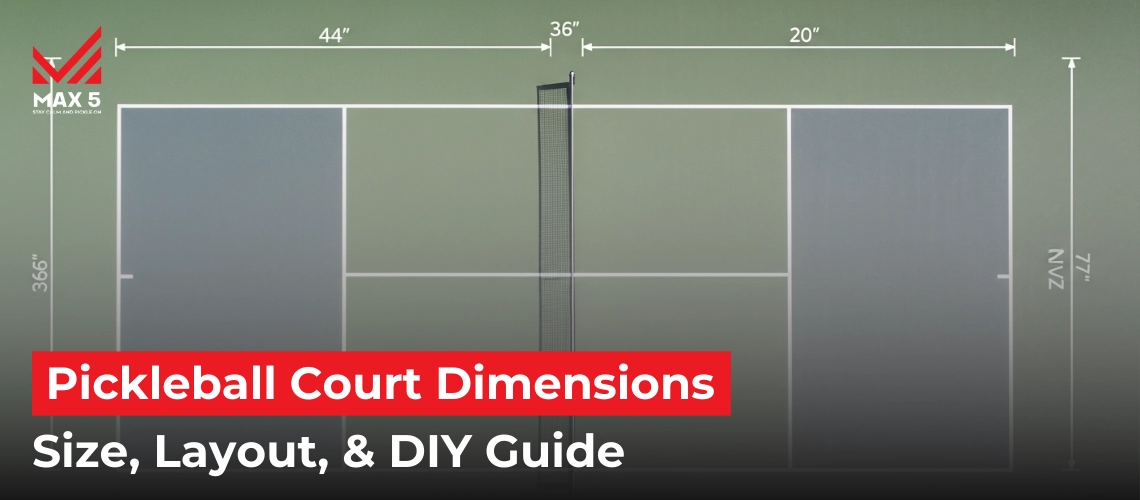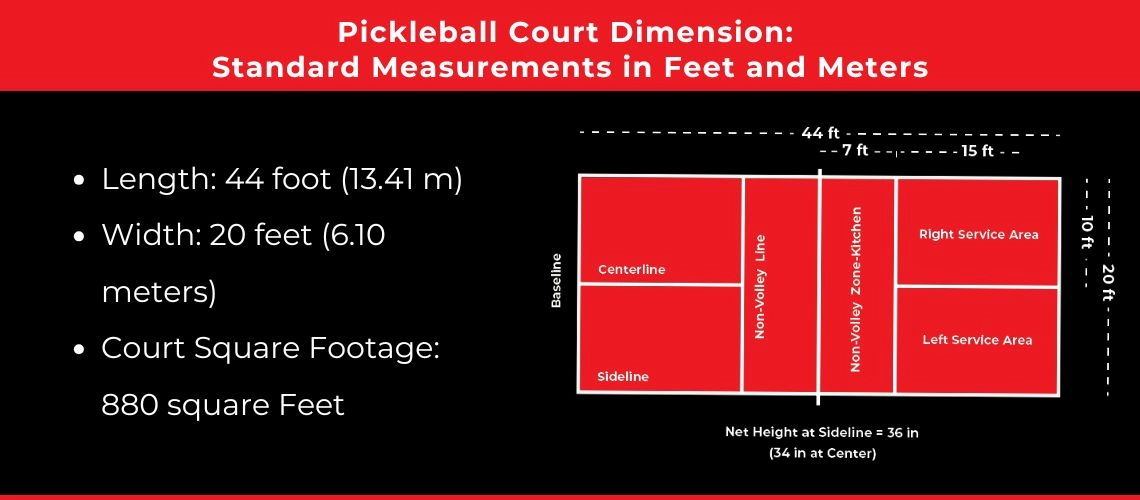
PickleBall Court Dimensions Size, Layout, & DIY Guide
The trend of pickleball is exploding, bringing pickleball to over 36 million players in the U.S. alone, according to some reports. There is an increasing demand for knowing the correct dimensions of pickleball courts, as more fans construct courts in their homes or install them in facilities and parks. You can install a tennis court, paint a driveway, or set out a gym floor, but accurate measurements make gameplay safe, even, and fun.
In this guide, you will learn:
- The official dimensions of a pickleball court in meters and feet
- Downloadable court diagrams and layout tips
- How to build your own court, from tools to materials
- Key differences between indoor and outdoor pickleball courts
- Cost estimates, DIY advice, and more
Your final result will be the ability to measure, plan, and construct your regulation quality court. Moreover, you’ll love playing with the Max5’s PicklePaddle, made from carbon fiber, available in striking red or sleek black
Pickleball Court Dimension: Measurements in Feet and Meters
According to the USA Pickleball (USAPA) the normal court size of the pickleball court guidelines is:
- Length: 44 feet (13.41 m)
- Width: 20 feet (6.10 meters)
- Court square footage: 880 square Feet
- Pickleball court size in meters: 6.1 m × 13.41 m
More importantly, these measurements are used in singles and doubles; that is, you do not require extra lines and courts. If you learn more practically with images, take this PDF.
Pickleball Court Size Conversion Chart (ft to meters)
Here’s a handy conversion table to reference both imperial and metric units:
|
Feature |
Feet |
Meters |
|
Full court length |
44 ft |
13.41 m |
|
Court width |
20 ft |
6.10 m |
|
Court area |
880 sq. ft |
~81.75 m² |
|
Kitchen (non-volley zone) depth |
7 ft |
2.13 m |
|
Service area (each half-depth) |
10 ft |
3.05 m |
|
Net height (center/posts) |
34 in / 36 in |
86.36 cm / 91.44 cm |
|
The total play area |
30 ft × 60 ft |
9.14 × 18.29 m |
|
Line thickness |
2 in |
5.08 cm |
Core Components of a Pickleball Court Layout
1. Net and Posts
- Net width: Minimum 21 ft 9 in to ensure full coverage
- Height: 34 in at center; 36 in at sidelines
- Posts: Positioned 22 ft apart
- Material: Polyethene or nylon mesh for durability
2. Kitchen Zone (non-Volley Zone)
- Depth: 7 ft from the net on both sides
- Rule: No volleys allowed while standing in the kitchen
- Purpose: Encourages strategic play like dinks and discourages close-line smashing
3. Court Lines
Every line must be 2 inches wide and painted:
- Baseline: End boundary line
- Sideline: Side boundary
- Non-volley line: Marks entry into the kitchen
- Centerline: Divides service areas
Lines should contrast sharply with your court surface to ensure visibility.
DIY Pickleball Court: Layout, Dimensions, and Setup
Tools and Materials
- Surface should be Flat, concrete, asphalt, or indoor gym flooring
- Measuring tape, chalk lines, and carpentry square
- Court stencil kit, laser level (optional)
- Pickleball net and post set
- Outdoor-rated court paint and 2″ rollers
- Line tape for temporary setups
Step-by-Step Guide to Building a Pickleball Court
1. Choose the Location
- A 30 × 60 ft area is ideal; the surface is smooth, flat, and free of debris.
2. Frame the Rectangle (20 × 44 ft)
- Mark corners with chalk or spray paint. Check diagonals to verify it’s a true rectangle.
3. Add Internal Components
- Draw kitchen lines 7 ft from the net, and draw centerlines in each service area (center-net to baseline).
4. Install the Net Post
- Drill into asphalt or gym flooring and tension the net to 34 inches at the center.
5. Paint or Tape the Lines
- Use rollers and masking tape for clean edges; for temporary blocks, high-contrast line tape works well.
6. Allow to Cure
- Let paint dry for 24 hours (longer in humid or cold conditions).
7. Add Lighting or Fencing (Optional)
- For permanent courts, install LED poles 20–30 ft high to evenly light the play area.
Pro Tip
Install wind screens or fencing lines (10 ft high) to reduce stray balls and improve play focus.
Pickleball Court Cost Breakdown
|
Court Type |
Estimated Cost |
|
Temporary DIY Setup |
$300-$800 (net + tape lines) |
|
Basic Outdoor Court |
$4,000-$15,000 (surfaced, painted) |
|
Full Professional Court |
$20,000-$35,000+ (fencing, lighting, surfacing) |
Tip: Want to cut costs? You can convert an existing tennis court into 4 pickleball courts (interlink pickleball court Vs tennis court) and save 60-80% on installation costs.
What Does a Pickleball Court Look Like?
A pickleball court layout resembles a miniature tennis court. It features:
- A rectangular playing area
- A net across the middle
- Sidelines, baselines, and centerlines
- A non-volley zone (kitchen) on both sides
The court is divided into two halves (22 ft × 20 ft each), with each half containing two service boxes and the kitchen zone.
Wondering how big a pickleball court is compared to a tennis court? A standard tennis court (60 ft × 120 ft) can accommodate up to 4 regulation-size pickleball courts (each 20 ft × 44 ft) with adequate spacing.
Indoor vs Outdoor Court Considerations
|
Feature |
Indoor Court |
Outdoor Court |
|
Surface |
Wood, vinyl for bounce & speed |
Asphalt, concrete with coating |
|
Lighting |
Controlled florescent/LED |
Solar/rain exposure necessitates poles |
|
Ball Type |
Lighter 26–30-hole balls (Indoor) |
Standard 40-hole outdoor balls |
|
Bounce behavior |
Consistent |
Slight variations due to grit/weather |
|
Line marking |
Tape or paint for multipurpose gyms |
Permanent acrylic paint |
Note: Regardless of surface, maintaining accuracy in court dimensions is key.
Special Topics for DIY Builders
• Tennis Court Conversions
A full tennis court can comfortably fit 4 pickleball courts side by side ideal for clubs wanting to diversify play offerings.
• Line Color Tips
Use bright colors (white, yellow, or teal) that contrast with the court’s base tone for high visibility.
• Portability Options
Portable nets and removable tape lines allow instant multi-sport conversions perfect for schools or community gyms.
• Maintenance Checklist
- Sweep the area weekly
- Repaint lines every 2-3 years
- Pressure-wash and resurface to improve traction
- Tighten net regularly to maintain proper bounce
If you have a paddle and you do not know how to clean it in then learn the Max5 guide to clean your paddle effectively.
Final Insights: Build It Right for Better Play
Summarizing the keys to creating a successful court:
- Precision matters: All measurements must match USAPA standards.
- Plan for extras: Ensure buffer space, lighting, and net durability.
- DIY is doable: With paint line kits, portable nets, or existing surfaces, building a court is highly accessible.
- Factor in cost: Temporary courts start around $300–$800; facilities can run much higher.
- Play smarter: Proper design affects safety, strategy, and comfort.
By staying accurate with your pickleball court length, width, kitchen zone, and net specs, you create a space that’s not only regulation-ready but also tailored for unforgettable rallies and community fun.
Conclusion:
No matter the scale whether building a backyard court or a full-size facility official pickleball court dimensions of 20 ft × 44 ft for play and 30 ft × 60 ft total area (including safety zones) must be followed for consistent, fair, and safe play. USAPA standards apply equally to singles and doubles no extra markings needed.
From net height to kitchen depth, accuracy ensures optimal performance and durability. Whether your budget is $500 or $30,000+, the specifications remain unchanged. For maximum savings, convert a tennis court into four pickleball courts. Build it right, and enjoy professional-level games, practice, and long-lasting fun.
Frequently Asked Questions
How large is a pickleball court?
20 × 44 ft overall, with a total area requiring 30 × 60 ft for safe play.
How wide are pickleball court lines?
Exactly 2 inches, to match official standards.
Is a singles pickleball court smaller?
Both singles and doubles pickleball use the same standard court dimensions no adjustments needed.
What are pickleball net dimensions?
36 in at sidelines, 34 in at center, with posts spaced 22 feet apart.
What’s the kitchen size?
Design the non-volley zone by measuring 7 feet from the net on each side across the 20-foot court width.
How many sq ft is a pickleball court?
The court measures 880 square feet, with the total playing area including safety buffers ~1,800 square feet.
Are indoor and outdoor courts the same size?
Yes, the dimensions remain the same. Differences lie in surface and weather resistance.
How much space do you need at minimum?
A 30 × 60 ft area is the absolute minimum for safe player movement.
What materials are best for outdoor surfaces?
Post-tension concrete or smooth asphalt with texturized coatings for grip and weather durability.

 Buy MX Clean Pickleball Eraser – Scuff & Dirt Removal
Buy MX Clean Pickleball Eraser – Scuff & Dirt Removal 
